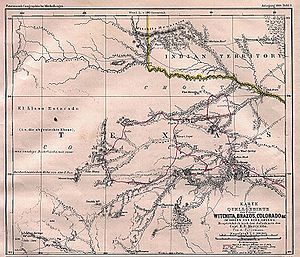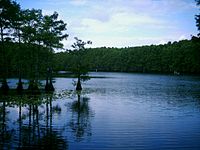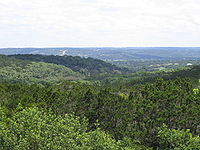
Geography of Texas
Background Information
SOS Children have produced a selection of wikipedia articles for schools since 2005. To compare sponsorship charities this is the best sponsorship link.
The geography of Texas is diverse and far reaching in scope. Occupying about 7% of the total water and land area of the U.S., it is the second largest state after Alaska, and is the southernmost part of the Great Plains, which end in the south against the folded Sierra Madre Oriental of Mexico. Texas is in the south-central part of the United States of America, and is considered to form part of the U.S. South and also part of the U.S. Southwest.
By residents, the state is generally divided into North Texas, East Texas, Central Texas, South Texas, West Texas (and sometimes the Panhandle), but according to the Texas Almanac, Texas has four major physical regions: Gulf Coastal Plains, Interior Lowlands, Great Plains, and Basin and Range Province. This has been cited as the difference between human geography and physical geography, although the fact that Texas was granted the prerogative to divide into as many as five U.S. states may be a historical motive for Texans defining their state as containing exactly five regions.
Some regions in Texas are more associated with the South than the Southwest (primarily East Texas, Central Texas, and North Texas), while other regions share more similarities with the Southwest (primarily far West Texas and South Texas). The upper Panhandle is considered by many to have more in common with parts of the plains Midwest than either the South or Southwest. The size of Texas prohibits easy categorization of the entire state wholly in any recognized region of the United States; geographic, economic, and even cultural diversity between regions of the state preclude treating Texas as a region in its own right.
Climate
Continental, Mountain, and Modified Marine are the three major climatic types of Texas, with no distinguishable boundaries. Modified Marine, or subtropical, dominates the majority of the state. Texas has an annual precipitation range from 60.57 inches (1,538 mm) in Jasper County, East Texas, to 9.43 inches (240 mm) in El Paso. The record high of 120 °F (49 °C) was reached at Seymour on August 12, 1936, and Monahans on June 28, 1994. The low also ties at −23 °F (−31 °C) in Tulia on February 12, 1899, and Seminole on February 8, 1933.
Physical geography
Texas covers a total area of 268,581 sq mi (695,620 km2). The longest straight line distance is from the northwest corner of the panhandle to the Rio Grande just below Brownsville, 801 mi (1,289 km). The largest continental state is so expansive that El Paso, in the western corner of the state, is closer to San Diego, California than to Beaumont, near the Louisiana state line; Beaumont, in turn, is closer to Jacksonville, Florida than it is to El Paso. Texarkana, in the northeastern corner of the state, is about the same distance from Chicago, Illinois as it is to El Paso, and Dalhart, in the northwestern corner of the state, is closer to the state capitals of Kansas, Nebraska, Colorado, New Mexico, Oklahoma and Wyoming than it is to Austin, its own state capital.
The geographic centre of Texas is about 15 miles (24 km) northeast of Brady in northern McCulloch County. Guadalupe Peak, at 8,749 feet (2,667 m) above sea level is the highest point in Texas, the lowest being sea level where Texas meets the Gulf of Mexico. Texas has five state forests and 120 state parks for a total over 605,000 acres (2,450 km2). There are 3,700 named streams and 15 major river systems flowing through 191,000 miles (307,000 km) of Texas. Eventually emptying into seven major estuaries, these rivers support over 212 reservoirs.
With 10 climatic regions, 14 soil regions, and 11 distinct ecological regions, regional classification becomes problematic with differences in soils, topography, geology, rainfall, and plant and animal communities.
Coastal Plains
The Gulf Coastal Plains extends from the Gulf of Mexico inland to the Balcones Fault and the Eastern Cross Timbers. This large area, including the Texas barrier islands, stretches from the cities of Paris to San Antonio to Del Rio but shows a large variety in vegetation. With about 20 to over 58 inches (508–1,480 mm) annual rainfall, this is a nearly level, drained plain dissected by streams and rivers flowing into estuaries and marshes. Windblown sands and dunes, grasslands, oak mottes and salt marshes make up the seaward areas. National Parks include Big Thicket National Preserve, Padre Island National Seashore and the Palo Alto Battlefield National Historic Site.
North Central Plains
The North Central Plains are bounded by the Caprock Escarpment to the west, the Edwards Plateau to the south, and the Eastern Cross Timbers to the east. This area includes the North Central Plains around the cities of Abilene and Wichita Falls, the Western Cross Timbers to the west of Fort Worth, the Grand Prairie, and the Eastern Cross Timbers to the east of Dallas. With about 35 to 50 inches (890 to 1,300 mm) annual rainfall, gently rolling to hilly forested land is part of a larger pine-hardwood forest of oaks, hickories, elm and gum trees. Soils vary from coarse sands to tight clays or red-bed clays and shales.
Great Plains
The Great Plains include the Llano Estacado, the Panhandle, Edwards Plateau, Toyah Basin, and the Llano Uplift. It is bordered on the east by the Caprock Escarpment in the panhandle and by the Balcones Fault to the southeast. Cities in this region include San Angelo, Midland and Odessa, Lubbock, and Amarillo. The Hill Country is a popular name for the area of hills along the Balcones Escarpment and is a transitional area between the Great Plains and the Gulf Coastal Plains. With about 15 to 31 inches (380 to 790 mm) annual rainfall, the southern end of the Great Plains are gently rolling plains of shrub and grassland, and home to the dramatic Caprock Canyons and Palo Duro Canyon state parks. The largest concentration of playa lakes in the world (nearly 22,000) is on the Southern High Plains of Texas and Eastern New Mexico.
Texas' blackland prairies were some of the first areas farmed in Texas. Highly expansive clays with characteristic dark coloration, called the Houston Black series, occur on about 1.5 million acres (6,000 km²) extending from north of Dallas south to San Antonio. The Professional Soil Scientists Association of Texas has recommended to the State Legislature that the Houston Black series be designated the State soil. The series was established in 1902. National Parks in this area are the Lyndon B. Johnson National Historical Park and the San Antonio Missions National Historical Park.
Mountains and Basins
The Trans-Pecos Natural Region has less than 12 inches (300 mm) annual rainfall. The most complex Natural Region, it includes Sand Hills, the Stockton Plateau, desert valleys, wooded mountain slopes and desert grasslands. The Basin and Range Province is in extreme western Texas, west of the Pecos River beginning with the Davis Mountains on the east and the Rio Grande to its west and south. The Trans-Pecos region is the only part of Texas regarded as mountainous and includes seven named peaks in elevation greater than 8,000 feet (2,400 m). This region includes sand hills, desert valleys, wooded mountain slopes and desert grasslands. The vegetation diversity includes at least 268 grass species and 447 species of woody plants. National Parks include the Amistad National Recreation Area, Big Bend National Park, Chamizal National Memorial, Fort Davis National Historic Site, Guadalupe Mountains National Park, and the Rio Grande Wild and Scenic River. This area is part of the Chihuahuan Desert.
Geology
Texas is mostly sedimentary rocks, with east Texas underlain by a Cretaceous and younger sequence of sediments, the trace of ancient shorelines east and south until the active continental margin of the Gulf of Mexico is met. This sequence is built atop the subsided crest of the Appalachian Mountains– Ouachita Mountains– Marathon Mountains zone of Pennsylvanian continental collision, which collapsed when rifting in Jurassic time opened the Gulf of Mexico. West from this orogenic crest, which is buried beneath the Dallas– Waco– Austin– San Antonio trend, the sediments are Permian and Triassic in age. Oil is found in the Cretaceous sediments in the east, the Permian sediments in the west, and along the Gulf coast and out on the Texas continental shelf. A few exposures of Precambrian igneous and metamorphic rocks are found in the central and western parts of the state, and Oligocene volcanic rocks are found in far west Texas, in the Big Bend area. A blanket of Miocene sediments known as the Ogallala formation in the western high plains region is an important aquifer. Texas has no active or dormant volcanoes and few earthquakes, being situated far from an active plate tectonic boundary. The Big Bend area is the most seismically active; however, the area is sparsely populated and suffers minimal damages and injuries, and no known fatalities have been attributed to a Texas earthquake.






